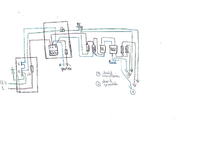Welcome. Single-family house, ground floor and attic. TNC mains system, single-phase. There are three switchboards - one main, outside the building with 25A main protection, the second one on the ground floor, which supplies the ground floor, and the third one, in the attic, supplies the attic. The main switchboard has a separation of PEN into PE and N. Measurement of the earth connection over 6 ?. There is one energy meter in the switchgear on the ground floor, from which the ground floor and the attic are measured. There is a 3x10mm cable from the main switchgear to the switchgear on the ground floor. The same goes from the switchboard on the ground floor to the switchboard in the attic. There is no PE conductor on the ground floor, only L and N. In the attic there are all three - PE, N and L. The installation is freshly installed. The PE conductor in the switchgear on the ground floor is connected by a strip with a PE conductor which goes to the attic. It is not distributed on the ground floor.
As it turned out, in the attic there is a voltage of 0.88V between N and PE, while between L and PE there is a voltage of 97 - 100V. L and N are normally 230V with a penny. Interestingly, after connecting the light bulb in the kitchen to the L and N wires, without PE, the differential breaks down from time to time. And what's more interesting, it crashes both the kitchen and the rooms. Not alternately, but sometimes he taps one and sometimes the other. The circuit of the differentials in the attic distribution board is connected correctly, no blue wire is confused between the differentials. All PE conductors are connected to one strip and no PE is connected anywhere with N. At least in the attic.
What's the problem? I mean something, but I'll wait for what you tell me.
I'm sorry that I am describing this installation, but at the moment I have no way of making a scan of the installation to post a schematic on the forum.
As it turned out, in the attic there is a voltage of 0.88V between N and PE, while between L and PE there is a voltage of 97 - 100V. L and N are normally 230V with a penny. Interestingly, after connecting the light bulb in the kitchen to the L and N wires, without PE, the differential breaks down from time to time. And what's more interesting, it crashes both the kitchen and the rooms. Not alternately, but sometimes he taps one and sometimes the other. The circuit of the differentials in the attic distribution board is connected correctly, no blue wire is confused between the differentials. All PE conductors are connected to one strip and no PE is connected anywhere with N. At least in the attic.
What's the problem? I mean something, but I'll wait for what you tell me.
I'm sorry that I am describing this installation, but at the moment I have no way of making a scan of the installation to post a schematic on the forum.




